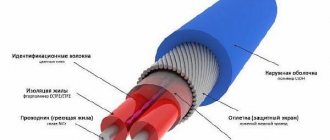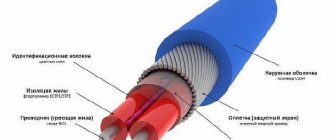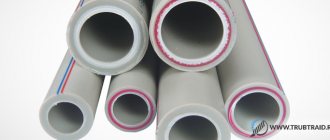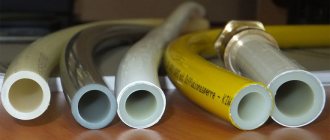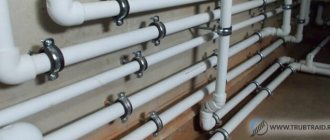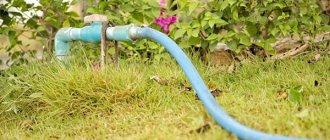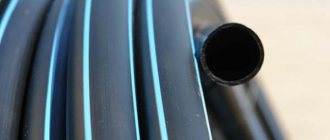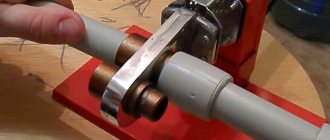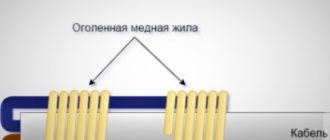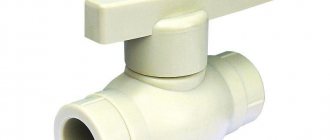The peculiarities of the modern climate dictate the need to provide any personal plot with irrigation water. Only in this case, dacha owners have the right to count on an acceptable harvest. If in past years there was simply no alternative to steel pipes, now it is much more profitable to install plastic pipes for irrigation in the country. They have a number of significant advantages compared to metal, as well as a more reasonable cost. This material will help you understand the question of which type of plastic pipes to prefer to ensure watering of your summer cottage.
Plastic pipe price
When purchasing materials for work, it is recommended to be extremely careful.
Plastic products, especially the ends, should not contain roughness or irregularities. The workpieces must have even roundness. The price for blanks for PP pipe mains is as follows. This is from 1 to 7 dollars per linear meter. The price of fittings is approximately within these limits.
The most expensive materials of this type are supplied by German and Italian companies. Products from Turkish and domestic manufacturers cost an order of magnitude lower.
Such a product costs a little more, but this is fully justified by the long-term and reliable operation of the constructed system.
Tips for choosing the right type of pipes
As can be seen in the drawings and photographs, various pipes can be used to install an irrigation system in a dacha. The choice depends:
- from material capabilities;
- on the degree of skill of the home craftsman;
- depending on the type of irrigation system chosen.
Metal pipes
These pipes are strong, quite durable and affordable, but at the same time they have a number of disadvantages that make them not the best option for irrigation systems: fittings, bends and taps are expensive; pipes are susceptible to corrosion; their installation is quite labor-intensive and requires special skills, so not everyone can do it; it is better to entrust it to a specialist. Better yet, opt for more modern materials, for example, choose plastic pipes for irrigation, especially since there are quite a lot of options.
PVC pipes
These pipes are the toughest of polymer pipes, inexpensive and practical. They are not afraid of temperature changes and are durable. They can be used for the installation of an above-ground central highway or an underground irrigation system.
PVC pipes are connected using special glue and fittings. It does not require any special equipment or any special skills.
An automatic irrigation system based on the sprinkling principle includes: an irrigation system controller, solenoid valves, sprinklers, pipelines and related devices.
Polyethylene pipes
This type of irrigation pipes is characterized by increased elasticity and strength. They will not burst if water freezes in them. For subsoil irrigation, polyethylene pipes with a diameter of 20 to 40 mm are used. Considering that a number of holes with a diameter of 2-3 mm or slots 5-10 mm long and up to 2 mm wide are made in them, and also that the earth presses on the pipes, the wall thickness should be from 1.5 to 2 mm.
The diagram of the drip irrigation system shows that the main line is made of PE pipes
Pipes made of cross-linked polyethylene are more resistant to temperature changes and are not afraid of sunlight. Installation of an irrigation system from them can be carried out by almost any craftsman who masters simple soldering techniques and purchases the appropriate apparatus.
Polypropylene pipes
in many respects they are similar to the previous option, but more economical. They boast a whole bunch of positive characteristics: strong, non-corrosive, durable.
They are connected using butt and coupling soldering, the technology of which is quite simple.
You can install drip irrigation yourself by purchasing a special pipe, hose and all the necessary accessories
Correctly selected pipes for drip irrigation will allow you to independently install one of the most economical irrigation systems, which is becoming increasingly popular both among farmers and ordinary summer residents.
Perhaps the best option for you would be to purchase a ready-made automatic watering system, which will reduce the “human” factor in such a troublesome task to a minimum. Many companies provide installation services for such systems.
Types of irrigation systems
The most important point that must be taken into account when designing a dacha irrigation system is the climatic conditions inherent in a given region. Depending on this factor, the type of system is selected, which, in turn, affects the set of system elements, its design and assembly sequence.
The following types of irrigation systems exist:
- Drainage systems. This method is optimal for areas with a large number of perennial plants that are constantly located in one place. The drainage water supply is laid once and for a long time, which makes it ineffective for watering a garden with regular changes in the location of the beds.
- Irrigation by sprinkling. This method assumes the presence of a pipeline through which irrigation will be carried out. The design of such a pipeline is usually calculated individually, depending on the situation, but a sprayer is always installed at its extreme section, due to which water is distributed between the plants.
- Drip irrigation. The drip irrigation method is characterized by maximum convenience and efficiency. Irrigation technology in this case makes it possible to minimize water consumption, which is extremely useful if the water supply system is equipped with a meter. You will have to select pipes for irrigation individually, depending on the characteristics of the site and the plants located on it. In addition, it will be necessary to correctly calculate the intensity and frequency of irrigation in advance.
- Surface watering. This technology can be effectively used only in regions where there is practically no precipitation, and even in such situations the surface irrigation method must be justified. Water supply is carried out using special ditches. The use of surface watering leads to disturbances in the soil structure, as a result of which air gets to the roots of plants.
Additional technical specifications
Modern improvements affect the performance of the hose
Pay attention to this when purchasing
Multi-layering
A single-layer hose is the thinnest, the casing has no additional internal or external layers. They do not tolerate climate change and are not resistant to changes in water pressure. Used and stored at positive temperatures. It is mainly used for short transfers of water: from a barrel to a bucket.
Multilayer hoses are durable, yet flexible and wear-resistant. Resistant to ultraviolet radiation and increased operating pressure. But at the same time they are quite elastic and curl well. They pass a large volume of water, which allows you to water a large number of garden crops.
Reinforcement
Rubber or silicone plastic pipes, into the walls of which reinforced threads made of polymers or steel are soldered to increase wear resistance and withstand high pressure. Frost resistance increases, but at the same time the weight of the hose increases. Well suited for summer stationary water supply, when the water supply is extended over the entire area during the summer and is removed with the onset of persistent cold weather.
The most durable reinforced hoses can withstand pressures up to 40 bar
When choosing, you need to pay attention to the size of the cells - the smaller they are, the stronger the hose
Expandable hose
An innovative invention of recent years. Unique hose-in-hose design. The inner layer is made of rubber and has high stretchability. The second, outer layer is made of nylon, designed to limit the stretching of the inner layer.
When filled with water, the hose increases in volume and passes a large volume of water through itself. After turning off the pump, all the water flows out and the hose shrinks in size to its original size. It is very light weight and has an interesting design. It is becoming increasingly popular among buyers.
Pipe diameter
Hoses have an interesting pattern: the longer, the narrower the diameter should be. If the hose is connected to a water tap, the diameter should be slightly smaller, it should be easy to put on the tap and not fall off when pressure is applied.
The most common diameters are ½ – 13 mm. and ¾ – 19 mm. The largest is 1 1/2 - 38 mm. The diameter of water pipes in Russia is measured along the inner rim.
Operating pressure
The hose with a large number of layers and reinforcement can withstand high water pressure up to 40 bar. Single layer will withstand a pressure of 2 bar
On reinforced hoses, you need to pay attention to the fastening to the tap; at high pressure, the heavy hose will fly off
Advantages and disadvantages of this option
Pros:
simple installation and operation;- lightness of the material;
- the most affordable price among polymer pipes;
- long service life;
- ease of connection using adapters;
- ability to withstand a wide range of temperatures (from -20 to +45 degrees; only chlorinated PVC can tolerate higher temperatures);
- frost tolerance (but in frost the material becomes more fragile and breaks more easily);
- lack of tendency to corrosion;
- tolerance to temperature changes (but with the onset of the cold season, it is better to remove the pipes).
Minuses:
- feasibility of underground installation;
- low performance qualities of single-layer hoses;
- release of harmful substances when the operating temperature is exceeded;
- relatively easy to damage by rodents and other mechanical factors.
Schematic diagram of an irrigation installation
You can install an irrigation system for a garden or summer cottage according to the diagram. This mechanism has a rain or drip irrigation circuit.
PHOTO: moezerno.ru Automatic watering connection diagram
The system operates very simply - a collecting device - a hose or pump - is connected to the water source. It is recommended to select main pipelines with a diameter of 1 to 1.5 inches. The tube that is led to the area for watering the plants in the garden bed should be of small diameter.
PHOTO: items.s1.citilink.ru Experts recommend installing a complete system for high-quality work. This implies the additional use of a storage tank together with an irrigation mechanism
For irrigation, you can use a regular plastic or metal container of a dark color with a large volume of liquid. To avoid overfilling the plants, a float is attached to the container, which is a kind of fill sensor.
It is best to place such a mechanism in a well-lit place, under the sun’s rays, then the water will also be heated, which is important for some plants
PHOTO: ae01.alicdn.com Option for creating drip irrigation for seedlings
For irrigation that simulates rain, dynamic and static sprayers in the form of rotors and fans are installed in the garden. If it is necessary to ensure a drip supply of liquid, special tapes are used.
Additionally, special computerized sensors are installed in each irrigation system that monitor the process of opening and closing valves for water supply. The owner of the site sets up a specific schedule, and then, when the specified time arrives, the valves open. The programmer must be installed in the place where the liquid distribution unit is already located. Water is automatically pumped using sediment. When the pressure drops, the valve opens on its own.
PHOTO: sam-stroitel.com To prevent failures and malfunctions, filters are installed, which is especially important for main systems
Laying process
When constructing your own garden watering from plastic or metal pipes, you should adhere to a certain algorithm.
- Draw on paper a pipeline laying diagram, mark the locations of the sprinklers so that the entire area is covered.
- Taking into account the number and location of sprinklers (sprinklers), possible hydraulic losses, select a pump of the required power and a water container.
- Mark the site according to the paper version of the project plan.
Important! When marking the lawn, you need to accurately place the sprinkler mounting points to avoid double watering of individual areas.
- Use a spatula to dig trenches measuring 22-30 cm into which the pipes will be laid. If there is a lawn, carefully place the soil on polyethylene.
- Assemble valve boxes, sprinkler units, pump with container.
- Using fittings, connect all nodes with pipes into a single system.
- Lay the electrical cable and connect it to the remote control.
- Launch and adjust the automatic irrigation structure. Make sure that all areas of the site are watered and that there are no overlays.
Do-it-yourself watering system at the dacha
Have you decided to make your own drip irrigation system? Don't be afraid, there is nothing complicated about it. In this article, we consider only those methods of watering a garden that everyone can do on their own.
Drip irrigation system using pipes
You will need:
- a reservoir for accumulating and storing water (1.5-2 m above the ground);
- large, dense pipe;
- several thin pipes (10-15 mm), depending on the number of beds;
- elements of the plastic part of a medical dropper (nozzle);
- plugs for thin pipes.
Start small: measure each of your beds, then cut the thin pipes to size. Connect a large pipe - a main line - to the water tank so that it lies perpendicular to the beds. Connect the pipe slightly above the bottom of the barrel/tank.
Experts advise choosing PVC pipes (a type of polymer pipe), they are dense, inexpensive and are not afraid of high temperatures. PVC pipe is suitable as the main pipe of your irrigation system. It is better to buy thin pipes for beds made of polyethylene - they are the most elastic and are also not afraid of frost.
Connect the thin pipes to the main pipe using starter fittings, having previously drilled the appropriate number of holes in it.
Lay the drip pipes parallel to the beds. Make several small holes in each pipe into which the elements of the drip system will be inserted.
The holes should be made directly near the root of the plant, which means how many plants there are, so many holes. Insert plugs on the back of each thin pipe.
Before testing your irrigation system, remove the plugs and “run” water through the pipes so you can more easily find out if your system is faulty. If you notice a flaw, fix it immediately.
Drip irrigation system using plastic bottles
The previous system doesn't seem too complicated and intricate, does it? If so, then this one will be even easier. To make it, you only need a few plastic bottles or containers.
You probably already understood the principle of operation of this system: holes are made in the bottle, drops from which fall under the plant.
However, even in such a simple system there are two options:
- Hanging bottles. Install a fastening above the bushes of the plant - for example, 2 wooden sticks on the sides perpendicular to the ground, one between them - parallel. Hang a plastic bottle of water on the last one, after making a hole or two in it. It is better to hang it upside down. Make sure that the support is strong enough so that the bush is not knocked down by sticks.
- Buried bottles for underground watering. Cut off the bottom of the bottle (larger containers will work here) and screw on the neck. Make several holes on the sides of the bottle (the denser the soil, the more holes. 4 is the maximum). Bury the bottle 15 cm into the ground between two bushes. Fill the bottle with water. Now it will gradually seep through the holes and nourish the roots of the plant. This method of watering lasts for 2-4 days, depending on the volume of the vessel.
Even if you are new to gardening, you can easily make drip irrigation systems with your own hands.
You will need little: a few materials that can be bought at any specialty store, a desire to please your plants with a regular supply of water, and a little patience! We are sure you will succeed!
Feeders for poultry
Feeders for chickens, geese and ducks.
There are many options for feeders and drinkers for poultry, which you can build yourself from medium-diameter PVC pipes. However, it is worth noting that when exposed to ultraviolet radiation, polyvinyl chloride deteriorates and becomes brittle, so such structures should not be used for more than one season.
What is needed for drip irrigation?
Drip irrigation systems are widely available and are completely ready for connection and further use. But such a design can be assembled independently. There are many methods for creating a drip irrigation system: even improvised means such as plastic bottles are used.
When choosing a pipe for drip irrigation, it is best to choose polypropylene products. A polypropylene pipe can be replaced with a polyethylene structure, but the first option is considered the most economical.
Also, drip irrigation requires a very carefully thought out system design. It is not enough to simply drill holes in the pipe at the same distance, since the water will be distributed unevenly: at the beginning of the hose, the liquid will flow under strong pressure, and at the end of the pipe, the liquid will only drip.
So, to create a drip irrigation design, the following details will be useful:
- emitter watering tape;
- plugs for drip tape;
- connecting fittings for pipes;
- hose coupling;
- mesh filter;
- plastic (polypropylene) pipes;
- fittings for butt connection of tape with pipes.
Another element, without which not only drip water supply, but also any other type of irrigation is impossible, is a water source. At a summer cottage, the source of water supply can be a well, a piped water supply, or a separate container. If it was decided to use a container of water (tank, barrel), then it should be placed at a distance of at least 1.5 meters above the ground. The higher the barrel is located, the higher the pressure and pressure will be. Thus, a barrel with a connected tape at a height of 10 m will consume at least 3-4 liters of water per hour. The water supply barrel must be closed so that debris does not contaminate the irrigation system.
For drip irrigation, a thin flexible pipe is suitable, and special tips will provide drops of water.
A filter for water purification is also useful for installing a watering system. Mesh, vortex or disc filters help extend the life of irrigation hoses: if the water is too hard, their replacement is inevitable within several years after installation. For a drip system, the most simple in design and inexpensive mesh filter is suitable. It is necessary that the size of the cells in the mesh does not exceed 130 microns.
Regardless of what type of irrigation structure was chosen, it is important to follow the technology and installation sequence. After connecting all elements of the wiring diagram, a leak test should be carried out to ensure efficient and safe operation of the system
Briefly about country irrigation systems
Irrigation of beds and fruit trees in the country using pipes can be organized in several ways. When choosing one system or another, you need to take into account the type of soil on the site, general climatic conditions and the desire (or unwillingness) to spend time watering the garden.
The manual method of moistening the soil is too labor-intensive. A country house is intended for relaxation. Often, city residents go to it on weekends to work there by the sweat of their brow. There are those who even really like this pastime. But most just want to relax outside the city. However, almost everyone has a small vegetable garden, apple trees and currants in their dacha. And they need to be watered.
All artificial irrigation systems for a summer cottage are divided into two types: automatic and semi-automatic - the first imply transferring control over the watering process completely to automation, and the second involve partial human participation
Based on the method of water supply, there are three types of non-manual irrigation systems:
- Drip surface.
- Subsurface.
- Sprinkling (sprinkling).
The technology for creating “artificial rain” is the most common. To install such a system in a summer cottage, it is necessary to install several rotary sprinklers and connect water pipes to them. However, such sprinklers waste too much water. Some of it simply evaporates before reaching the soil. This type of country irrigation is mainly intended for watering large lawns.
Two other options for automatic watering systems involve supplying moisture to or onto the soil directly next to the plant being watered. For this purpose, perforated pipes, droppers and bubblers are used. This method of irrigation is more economical in terms of water consumption, but due to the large length of water pipelines it is more expensive to install.
For an underground irrigation system, a perforated pipeline will have to be buried in the ground at a depth of 20–30 cm, but for a surface pipe it can be laid on the ground
Pipes for all types of garden watering are selected according to diameter in the range from 25 to 32 mm. If the pressure in the central water supply at the dacha is low or water is supplied to the system from the tank by gravity, then the cross-section should be closer to the upper limit. Otherwise, you can save money by taking pipes and fittings with a diameter of 25–27 mm.
With smaller values, the pipeline will work ineffectively, watering the ground for too long. And with large sizes it will turn out to be an unnecessarily expensive pleasure. The flow of water will still only fill such a pipe halfway. And large-diameter pipe products are obviously more expensive than their thinner counterparts.
How to water plants correctly
In addition to the correct selection of the type of watering and its proper organization, it is necessary to follow basic rules that will make moisturizing as beneficial as possible:
- The main rule is that any watering must be systematic. In other words, it should not depend on either the month or the hours of watering. Ideally, there should always be a spare water tank.
- It is better to water less often, but abundantly. During periods of extreme heat, minor but frequent watering not only does not bring any benefit, but can also harm the plants. Moisture still does not reach the main roots, but a hard crust quickly forms on the soil, which not only limits oxygen access, but also increases water evaporation.
- The bulk of the roots are located at a depth of 20-25 cm for fertile crops and at a depth of about 15 cm for lawn grass. To completely wet soil 25 cm deep, about 25 liters of water per 1 m2 are required. Lawns can be periodically refreshed during dry periods.
- The temperature of the water for irrigation also plays an important role. If you take water directly from a well or well, it will have a temperature of about 10-12°C. This will be a shock for the plants, which will lead to their weakening. Ideally, the water temperature should be the same or slightly higher than the soil temperature. It is clear that no one will specifically heat water for irrigation, but it is advisable to acquire a storage tank. Its volume can be either 200 or 5000 liters, depending on the area of the site. While in the tank under the sun, the water will warm up to an acceptable temperature.
- To ensure sufficient pressure in an automatic irrigation system, it should be located at a height of 2-3 meters above the ground or higher. A height difference of 1 meter can create a pressure equal to 0.1 bar. For the normal functioning of many systems, the minimum pressure must be at least 2-3 bar. For this reason, special pumps are often installed.
- It is a mistake to think that if it rained today, then the area does not need watering. Sometimes even heavy precipitation is not able to adequately moisten the soil to the required depth. You can reduce the duration of watering by first assessing the condition of the soil, but do not cancel it altogether.
- Water consumption rates for vegetable crops reach their maximum value during the period of intensive growth - from late spring to mid-summer. It is during this period that the speed of plant development is determined by the amount of water it consumes. The average norm is 10-15 l/m2 per week.
- Watering should be either morning or evening, when the sun does not have such a negative effect on young plants.
- Before choosing a particular type of watering, be sure to study the needs of the plants you grow. Perhaps they are contraindicated from getting water on the leaves.
Review of models and manufacturers
The selection of equipment begins with an inspection of how much a particular model costs.
But it is important to pay attention to the manufacturer. Here are several options for water pumping/pumping equipment that are deservedly popular:
- A water jet is equipment designed for pumping flows from a well/borehole. The throughput of insoluble inclusions is low, price starts from $80
- Baby - a design ideal for summer cottages. Low performance affects the low price (from $40).
- A brook is a device for supplying water from wells and wells of medium depth. Unpretentiousness to the percentage of contamination, excellent performance, ease of installation and lightness of the device are complemented by low cost (from $30), but the service life is no more than 3-5 years.
- The Gilex model range is equipment intended for domestic use in both water supply and sewerage systems. Excellent practical qualities, work with different depths, unpretentiousness to contamination, a very long service life and good maintainability are clear advantages of the brand. Equipment cost from $200
- Belamos - models are used for supplying clean drinking water and irrigation. They have a built-in control unit, which makes the units easier to use, and can operate in manual, automatic and scheduled modes. There is also a filter to improve the quality of the supplied flow, overload protection, productivity up to 2800 l/hour, supply depth up to 8 meters. Price from 150 $
- Gardena is a brand of highly reliable equipment. Universal devices are able to cope with the supply of liquid without interruptions to high floors, be used for irrigation and at the same time are unpretentious to contamination, as they are equipped with a high-quality filter. Power up to 4000 l/hour, readiness for use immediately after purchase, the presence of 2 outlets for a hose (for irrigation and supply of drinking water), a low noise threshold and a drainage tube for draining liquid add advantages to the device. Price from 120 $
- Aquarius is an ideal pump for wells up to 45 meters deep. The reliability of the unit is confirmed by the execution of parts made of brass and stainless steel, there is a thermal relay, as well as complete immunity to power supply fluctuations (performance will decrease, but the device will not break). Silent operation is also a plus, but it is better to use the unit on clean flows. Price from 120 $
- Vortex – pumps for deep wells (from 60 meters). Chrome parts, a durable body, a pressure of up to 100 meters and a price from $100 are the advantages of the unit. But energy consumption up to 1100 W is a drawback. However, the presence of overheating protection functions, smooth running, high pressure, and high-quality assembly exceed the disadvantages.
All presented models from the Russian manufacturer have unique features - they are adapted to power outages, are resistant to mechanical stress and are easy to install. For users who prefer more expensive units, there are alternative options:
- The Grundfos model range is an offer from German manufacturers. The company produces equipment for supplying and pumping liquids from wells, boreholes, and reservoirs. The devices are equipped with sensors for overheating, overload, protection against dry running and voltage surges. Such functionality significantly extends the life of the devices, but raises the price to $150. However, no matter how much the units cost, they deserve their price - the brand, according to consumers, is considered a leader in its field.
- Unipump is a brand of equipment indicated for use in wells with a high content of insoluble inclusions (up to 100 g/m3). Supply height up to 52 meters, productivity up to 4.8 m3/hour. There is overheating protection, soft start, and automatic operation, but you will have to be careful when using it if the liquid is very hard. Price starts from $110, efficiency and noiselessness are advantages, but a weak network drive is a disadvantage of the equipment.
A preliminary analysis of the needs, the design of the water intake source, determination of the length of the flow supply and the functional features of the water supply will allow not only to choose a good quality device, but also to correctly determine exactly how many pumps will be required for the uninterrupted supply of water to a house, farm or suburban area.
Which pipes to choose for watering the garden - useful tips
Modern man has long ceased to rely on the mercy of nature and seeks to protect himself from its unpleasant surprises. Having planted a garden or vegetable garden, a zealous owner will not count on rain, but will take care of watering. We will try to find out what types of irrigation systems exist, and which pipes for irrigation in the country house and garden plot are better to choose.
How can you water your garden?
No one will argue with the fact that timely and sufficient watering is the key to a good harvest. As well as the fact that it can be carried out in various ways, depending on the climate, terrain and, directly, the plants grown. The most common watering methods:
- Surface – water is supplied through open channels (holes, grooves).
- Subsoil irrigation is carried out using pipes with holes in the ground.
- Sprinkling - water enters the site through a closed pipeline, then is distributed from above to the plants using various devices.
- Drip irrigation involves supplying water directly to the development zone of the root system.
Drip irrigation is one of the most economical; the system allows water to flow directly into the root development zone
For at least three of the presented methods, it would be rational to install a stationary water supply system, the so-called distribution pipeline, and use not elastic and short-lived hoses, but pipes for watering the garden made of strong and durable materials.
Tips for choosing the right type of pipes
As can be seen in the drawings and photographs, various pipes can be used to install an irrigation system in a dacha. The choice depends:
- from material capabilities;
- on the degree of skill of the home craftsman;
- depending on the type of irrigation system chosen.
Metal pipes
These pipes are strong, quite durable and affordable, but at the same time they have a number of disadvantages that make them not the best option for irrigation systems: fittings, bends and taps are expensive; pipes are susceptible to corrosion; their installation is quite labor-intensive and requires special skills, so not everyone can do it; it is better to entrust it to a specialist. Better yet, opt for more modern materials, for example, choose plastic pipes for irrigation, especially since there are quite a lot of options.
PVC pipes
These pipes are the toughest of polymer pipes, inexpensive and practical. They are not afraid of temperature changes and are durable. They can be used for the installation of an above-ground central highway or an underground irrigation system.
PVC pipes are connected using special glue and fittings. It does not require any special equipment or any special skills.
An automatic irrigation system based on the sprinkling principle includes: an irrigation system controller, solenoid valves, sprinklers, pipelines and related devices.
Polyethylene pipes
This type of irrigation pipes is characterized by increased elasticity and strength. They will not burst if water freezes in them. For subsoil irrigation, polyethylene pipes with a diameter of 20 to 40 mm are used. Considering that a number of holes with a diameter of 2-3 mm or slots 5-10 mm long and up to 2 mm wide are made in them, and also that the earth presses on the pipes, the wall thickness should be from 1.5 to 2 mm.
The diagram of the drip irrigation system shows that the main line is made of PE pipes
Pipes made of cross-linked polyethylene are more resistant to temperature changes and are not afraid of sunlight. Installation of an irrigation system from them can be carried out by almost any craftsman who masters simple soldering techniques and purchases the appropriate apparatus.
Polypropylene pipes
in many respects they are similar to the previous option, but more economical. They boast a whole bunch of positive characteristics: strong, non-corrosive, durable.
They are connected using butt and coupling soldering, the technology of which is quite simple.
You can install drip irrigation yourself by purchasing a special pipe, hose and all the necessary accessories
Correctly selected pipes for drip irrigation will allow you to independently install one of the most economical irrigation systems, which is becoming increasingly popular both among farmers and ordinary summer residents.
Perhaps the best option for you would be to purchase a ready-made automatic watering system, which will reduce the “human” factor in such a troublesome task to a minimum. Many companies provide installation services for such systems.
How to assemble a water pipe
When assembling a water supply system at your dacha with your own hands, you need to decide which parts of the site you need wiring to. It goes without saying that water should be supplied to the house. But in addition to installing water supply throughout the house, for watering, you need to install pipes in key places on the site and install taps on them. If necessary, connect a hose to them and, moving it from place to place or installing a sprinkler, water the nearby beds.
Read here how to install water into the house, and we’ll talk further about how to install the water supply in a summer cottage with your own hands. It is most convenient to draw a plan to scale. If you already have beds, you can easily determine where the water needs to be delivered. It is better to make several water collection points: long hoses are inconvenient and difficult to carry, and having the ability to connect several at the same time, you will cope with watering faster.
The tap in the system should be located at the exit from the house and before the first branch
When drawing up the diagram, do not forget about the need to install taps on the main line: the cut after the branch is still in the house, and then, on the site, before the first branch. It is advisable to install valves further along the main line: this way, in case of problems, it will be possible to turn off the emergency section.
Even if a summer water supply system is installed, you will need to drain the water from the pipes so that when it freezes it does not burst them. To do this, you need a drain valve at the lowest point. Then it will be possible to turn off the tap in the house and drain all the water, protecting the water supply from damage in the winter. This does not have to be done if the country water pipes are installed from polyethylene pipes (HDPE).
After drawing the diagram, count the footage of the pipes, draw and consider what fittings are needed - tees, angles, taps, couplings, adapters, etc.
In order to correctly calculate the material and do the correct wiring of the water supply system in your dacha with your own hands, first draw a plan where you can calculate the footage and the number of fittings
Then you need to decide on the mode of use. There are two options: summer and winter water supply. They differ in the depth to which the pipes are buried. If you have an all-season dacha, then you will have to lay insulated water supply into the dacha itself or bury it below the freezing depth. For the installation of irrigation pipes in the country, it is more rational to use the summer version of the water supply system. You will only need a winter one if you have a greenhouse equipped. Then the section of the water supply to the greenhouse will need to be seriously equipped: dig a good ditch and lay insulated pipes.
Summer water supply at the dacha
Depending on what kind of pipes you use, they can be left at the top, or they can be laid in shallow ditches. Installing a country water supply system underground will take longer, but it is more reliable.
Do-it-yourself surface installation of a water supply system for irrigation in a dacha can be done quickly, but pipes lying on the surface can be damaged
Having decided whether you need trenches or not, and having dug them if you chose the underground option, the pipes are stretched and laid out around the site. This way the correctness of the calculations is checked once again. Then you assemble the system. The final stage is testing - turn on the pump and check the quality of the joints.
Before installing the water supply system at the dacha, the pipes are laid out in the right places
Winter water supply differs from summer water supply in that areas that will be used during the cold season must be guaranteed to be protected from freezing. They can be laid in trenches below the freezing depth, and/or insulated, and/or heated using heating cables.
Organization of automated drip irrigation
The presence of various automation systems (for example, timers or controllers) is a great way to make the life of any gardener much easier.
So, for example, if you set a timer on a water source, the water will turn on and off at specified time intervals. Automatic watering is a great solution. Especially if it is not possible to visit the beds often.
To make the right choice, a summer resident should take into account the following device parameters:
- degree of power;
- resistance to chemical compounds;
- the noise level it creates during operation.
In other words, the pump must be powerful enough, not too noisy and not react to fertilizers.
What kind of pipes are used for irrigation in the country?
If in the last century the only available option for organizing any water supply systems, including irrigation ones, were metal pipes, now the list of materials has become much more impressive. We can distinguish the following types of irrigation pipes, each of which has its own characteristics:
- Watering pipes made of steel. Durable metal pipes, the main disadvantage of which is their high susceptibility to corrosion processes. It should also be taken into account that water that is usually used for irrigation is less purified than drinking water; therefore, in steel lines, overgrowths of the internal walls of the main line are formed quite quickly (within 5-7 years). Because of this, it may be necessary to completely or partially replace the water line, especially if a pipe with a small diameter was originally chosen for it.
- Pipes made of non-corrosion metals: copper, stainless steel. Owners of pipelines made from these materials do not face the problems inherent in steel pipelines. But in private areas, copper pipelines and stainless steel systems are not used due to their very high cost.
- Plastic pipelines. Polymer pipes are an ideal option for creating irrigation water pipes. The plastic is very light, not susceptible to any biological or atmospheric factors (with the exception of pipes made of polypropylene, low-density polyethylene, the structure of which is destroyed due to the influence of ultraviolet radiation).
There are several types of plastic pipes suitable for irrigation systems:
Polyprolene pipes. A durable and rigid pipe made of polypropylene can be an excellent basis for a country irrigation system. It is worth considering that the lack of flexibility of this material entails the need to use additional elements (corners, tees) to organize turns. The connection of polypropylene pipes is carried out using diffuse welding.
Important! Since ultraviolet radiation negatively affects the condition of polypropylene, it is advisable to protect the pipeline from sunlight. In this case, the irrigation system will last much longer
- Polyethylene pipes. HDPE is a more elastic material than polypropylene, but also highly durable. Polyethylene can withstand low temperatures well, so a system made of this material does not need insulation: the pipe will not burst if water remains in it in winter. Polyethylene products can be thick-walled or thin-walled. The first type is used for main irrigation lines, the second - for drip tape irrigation.
- Products made of polyvinyl chloride. They have all the advantages of plastic structures: light, rigid, but quite elastic. They can be used for both above-ground and underground plumbing. One of the positive qualities of PVC is the ability of the material to self-extinguish upon fire. True, a polyvinyl chloride pipe is not best suited for use at low temperatures: under the influence of frost, the plasticity of the material decreases.
- Metal-plastic watering water supply. An excellent combination of the strength of metal pipes and the lightness of plastic structures. Metal-plastic products do not require welding or threading to create connections. However, we should not forget that to connect metal-plastic water pipes, metal fittings (mostly brass) are used, which sooner or later undergo corrosion.
Today, irrigation systems use lightweight polymer pipes, which are not inferior in many characteristics to steel ones.
One of the important parts of irrigation water supply in a country house can be called flexible hoses. They provide convenience and mobility when watering large areas of the garden manually. Laying stationary lines from flexible hoses is undesirable, since the soft material reacts negatively to constant exposure to ultraviolet radiation and high temperature. Flexible hoses are also not suitable for laying in the ground: in this case, the tube is very often pinched from the load.
Features of metal water pipes
Products made from polymer compounds are now used everywhere. This material does not rust, is cheap and easy to install. But metal has not yet been written off either.
At domestic dachas you can find a lot of metal water pipes used for watering plantings on the site. In many ways, this is a legacy of the Soviet era, when polymer pipes simply did not exist. However, not everything is so simple; metal has a lot of advantages.
Owners of summer cottages prefer to install irrigation using metal pipes because of their durability and strength - if you accidentally step on them, they will definitely not break
Among the advantages of metal irrigation pipes are:
- resistance to fractures;
- frost resistance;
- long service life of 20–30 years;
- high mechanical strength.
Metal water conduits can be safely laid under pedestrian paths and areas near the garage where vehicles are parked. They will not break under pressure from above. They may bend, but will not break.
Polymer products are unlikely to withstand such loads. Polymer pipes are too fragile compared to rolled metal pipes. And in winter, it is better not to use water pipes assembled from them without insulation outdoors at all.
Metal pipes for organizing irrigation in the country are made from suitable materials:
- become;
- galvanized steel;
- copper
The main disadvantage of the first option is its high susceptibility to corrosion. When a steel pipeline is in the ground, it quickly begins to rust, inside and out. The use of galvanized stainless steel with greater corrosion resistance allows you to extend the service life of such a water pipeline, but leads to its significant increase in cost.
Image gallery
Photo from
Stationary country pipeline
Connecting hoses to metal pipes
Combination of metal and polymer pipe
Shut-off valves for metal pipes
Copper pipes are not susceptible to rust, but they cost a lot. Plus, we must not forget about the problem of theft. Not all holiday villages are protected. And copper is a desirable prey for uninvited visitors who visit other people’s empty dachas in winter with the aim of stealing. It will always be in price at scrap metal purchasing bases.
Compared to their plastic counterparts, metal pipes are expensive, heavy and more difficult to install, but if they are not stolen, they will last much longer than their counterparts
Often the irrigation system is installed in the ground. Digging it up for the winter means loading yourself with additional work. Usually it is preserved and remains in the ground. But plastic becomes brittle in cold weather, which often leads to its destruction.
And steel and copper can easily withstand negative temperatures. Pipes made from them can be safely left in the ground for the winter. You just need to drain the water from them before it gets cold.
The following article will introduce you to the markings and assortment of fittings for connecting steel pipes, which we recommend reading.
Which watering hose to choose
1. The most common and practical are rubber and polyvinyl chloride or silicone reinforced. The former can be made from recycled materials and be toxic - they are suitable for irrigation. Only food grade versions are suitable for drinking water supply. The second and third ones are environmentally friendly.
2. Corrugated plastic and nylon devices are short-lived, but cheap, so it is advisable to keep them in reserve and use them periodically. If you intend to use it, you need to take into account that they are designed for pressures up to 5 bar.
3. To ensure greater water supply per unit time, diameters of 3/4', 5/8', 1' are selected. If the pressure is up to 2 bar, the optimal size is 1/2ʺ.
4. For ease of use, an additional trolley with a reel is purchased. As an option, you can simply buy a stretchable spiral version or a modification like Xhose, as a result of which comfortable watering of the flowerbed will be ensured.
5. If irrigation is necessary, the best solutions are: oozing hoses with micro-holes along the entire length and special flexible drip irrigation pipes with 3 channels. They can be placed at the roots of plants both on the surface of the earth and in its thickness.
6. To simulate natural watering, sprinklers with nozzles are purchased - such products operate in several effective modes, including automatic.
Useful tips
To avoid any problems during the installation and use of the drip irrigation system, it is advisable to pay attention to the following useful recommendations:
- In the process of irrigating a large plot of land, it is necessary to create quite a lot of pressure inside the pipes.
- As an alternative to raising the water container to a greater height, you can use the pump by installing it on the central line.
- The easiest and most convenient way to automate the irrigation system is by installing a microcomputer. This part is installed in the central line and thus controls the irrigation process at the specified parameters. And instead of ball valves, solenoid valves are used.
- Thin diameter outlets can be easily replaced with regular drip tape. On the other hand, these tapes are more vulnerable to mechanical damage (including birds and rodents).
- To ensure that the cuts on polypropylene pipes are smooth and do not bend during operation, it is advisable to make these cuts with a special tool - pipe cutting scissors. If you can’t buy these, you can also use a hacksaw. And for pipes with a small diameter, use a regular stationery knife.
Factors determining the choice of pump type
There are many types of pumps for watering summer cottages. True, they were not created specifically for summer residents, but they have one thing in common - working with water. But the selection of the device depends on what kind of water you are going to pump and where you will get it from. For plants, water does not have to be perfectly clean and transparent. They require warm, preferably settled water without harmful impurities and chemical waste from production. The ideal option is rainwater, which the owners accumulate in different containers throughout the site.
More often, water is taken directly from a well or borehole. But its temperature is quite cold, and if you constantly water the plants with such water, then the root system of many crops will begin to rot (for example, cucumbers). To warm up well water, summer residents raise it to the surface and let it warm up in some containers for several hours. And then they scoop it up with buckets and water it. Residents whose dachas are located next to natural reservoirs also collect water using the same system. They put it in barrels, let it sit for a couple of hours and then start watering.
If the landscape of the site includes artificial reservoirs (a pond or a home pool), then you can use water to water them. It will be warm and settled, but in this case the pool cannot be cleaned with chemicals, otherwise all the “chemistry” will end up on your table with the vegetables. This watering option provides a double benefit: you will periodically refresh the liquid in the reservoir and find where to put the old one.
The water in all of these sources differs in the degree of contamination. And when choosing garden pumps for irrigation, be sure to take into account the place from which the water will be drawn. For each source, separate types of surface, submersible, drainage and other units have been developed.
Planning and installation of a plumbing system
It should be taken into account that water supply in a country house may be needed for various purposes. This may be required not only for watering a garden, vegetable garden or greenhouse, but also for other purposes:
- It may be necessary to provide the country house with drinking water.
- Sometimes process water is needed not only for irrigation, but also for the dacha itself.
- In some cases, the owner is not interested in creating a permanent plumbing system, but in a temporary one, which is made for a specific use.
Once the purpose of the system being created has been chosen, it is necessary to design it in accordance with specific requirements.
Conclusion
Hoses in a suburban area are necessary. How to use? For watering the garden, washing the car, the facade of the house, windows. Or you can splash around in the heat and have fun.
Errors when choosing will not arise if you carefully study all the information about the technical characteristics. When going to stores, you need to know how long the hose is needed and for what period you decide to purchase the hose. Where the hose will connect to the water supply or pump, be sure to find out the cross-section of the pipe. This will save you from going to the store again for additional adapters.
If you rented a dacha for one year, it is easier and cheaper to buy a single-layer one. For a long term it is necessary to buy a solid product. You can buy several different ones and see which one will work best on your site.
Country life should be easy and pleasant. Running around with watering cans and buckets is not for us. We choose the best hose and enjoy a fragrant garden and a luxurious vegetable garden. We transfer complex gardening chores to modern technology and enjoy nature.
